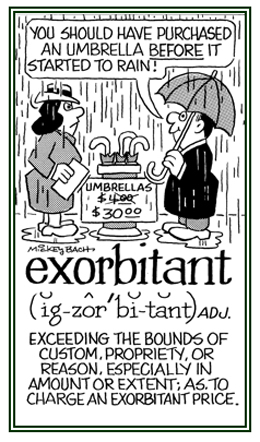orb-, orbito-
(Latin: rut or track made in the ground by a wheel; circle, ring, round surface, disk)
Also used in its extended anatomical sense as, "the portion of the skull immediately surrounding the eye".
2. Pertaining to, or situated in, the region in front of the orbit.
2. To cause to deliberately depart from orbit.
In physics, an orbit is the path that an object makes around another object while under the influence of a source of force; such as, gravity.
The exorbitant gas prices made some people quit driving their cars for awhile.
Exorbitant interest rates often decrease the number of buyers who really want to purchase houses.
2. Etymology: a legal term, "deviating from rule or principle, eccentric"; from Latin exorbitantem, exorbitans, exorbitare, "to deviate, to go out of the track", from ex-. "out of" + orbita, "wheel track".

Go to this Word A Day Revisited Index
so you can see more of Mickey Bach's cartoons.
2. Between the orbits; such as, the interorbital septum (a dividing wall or partition, a general term for such a structure).
A sphincter is a circular muscle constricting an orifice. In normal tonic condition, it closes the orifice; that is, the muscle must relax to allow the orifice to open.
2. Orbicular; rounded.
2. A small, disk-shaped structure.
2. The curved path, usually elliptical, described by a planet, satellite, spaceship, etc., around a celestial body, as the sun.
3. The path of a body in a field of force surrounding another body; for example, the movement of an atomic electron in relation to a nucleus.
4. A range of activity, experience, or knowledge; a range of control or influence.
5. The usual course of one's life or range of one's activities.
6. The sphere of power or influence, as of a nation or person: a small nation in the Russian orbit.
7. In physics, the path traced by an electron revolving around the nucleus of an atom.
8. An orb or sphere.
9. In zoology, the part surrounding the eye of a bird or insect.
10. Either of two bony cavities in the skull containing an eye and its external structures; an eye socket.
The bony pyramid-shaped cavity of the skull that contains and protects the eyeball. It is pierced posteriorily by the optic foramen (which transmits the optic nerve and ophthalmic artery), the superior and inferior orbital fissures, and several foramina. It is also formed by the frontal, malar, ethmoid, maxillary, lacrimal, sphenoid, and palatine bones.

